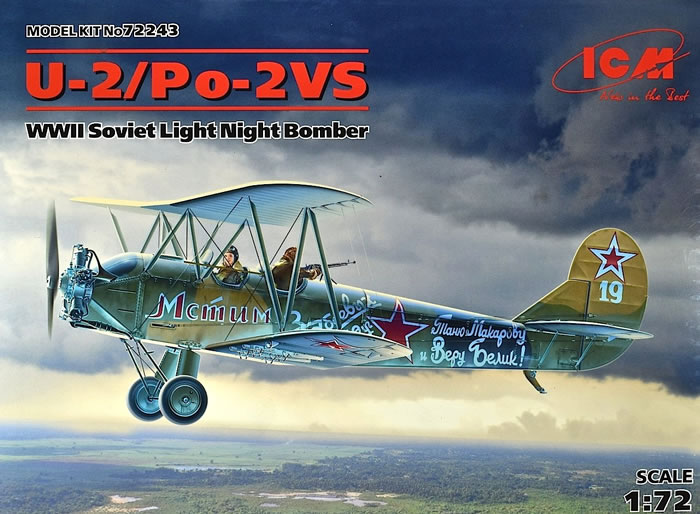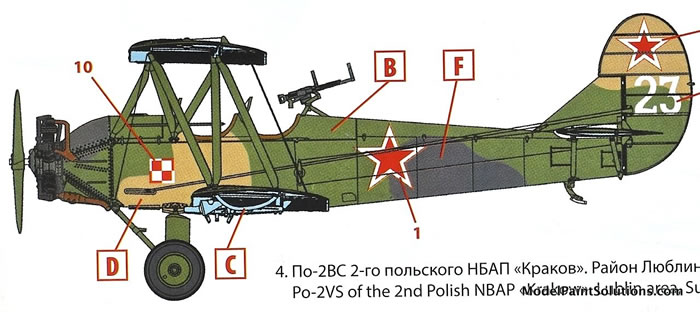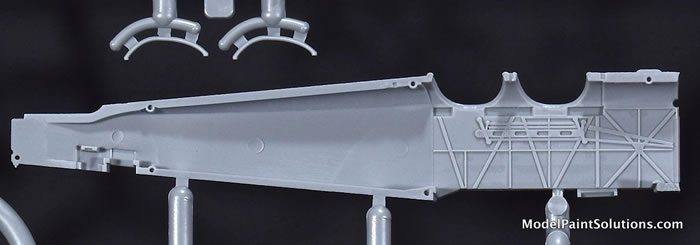Polikarpov U-2/Po-2VS

ICM, 1/72 scale
S
u m m a r y : |
Description and Item No.: |
ICM Kit No. 72243 - Polikarpov U-2/Po-2VS |
Contents and Media: |
Around 100 parts in grey styrene (not all are used), 3 in clear, and one decal sheet with markings for 2 airframes. |
Price: |
£9.99 EU Price (£8.33 Export price) Plus Shipping at Hannants
and hobby shops worldwide and online. |
Scale: |
1/72 |
Review Type: |
First Look |
Advantages: |
Conventional engineering, crisply molded parts, and very little flash will make for a relatively quick build. |
Disadvantages: |
No instrument panel decals. |
Recommendation: |
With a simple, straightforward layout incorporating single-piece upper and lower wings this kit looks like it will be a relatively quick and easy build. |
Reviewed by John Miller

Airfix's 1/72 scale Sea King is available online from Squadron.com
Once again, as I walked the model aisles of Skyway Hobby Shop (my usual weekend haunt) I find, hidden in the stacks, a model I meant to pick up previously but thought I’d missed: the ICM Po-2. I’ve liked ICM kits for a while and have a general and longstanding interest in anything Polikarpov so, done deal! I know you understand. Leave it to Emil, the evil owner of Skyway to
have one of these hummers squirreled away on one of his many crowded shelves.
Background:
The Polikarpov Po-2 (also U-2, for its initial uchebnyy, 'training', role as a flight instruction aircraft) served as a general-purpose Soviet biplane, nicknamed Kukuruznik (Russian "maize duster" or "crop duster"), NATO reporting name "Mule". The reliable, uncomplicated concept of the Po-2's design made it an ideal training aircraft, as well as doubling as a low-cost ground attack, aerial reconnaissance, psychological warfare, and liaison aircraft during the war. It proved to be one of the most versatile light combat types to be built in the Soviet Union.
It may be the most produced biplanes in history, with as many as ~30,000 Po-2s built between 1928 and 1959. Exact figures are hard to obtain since low-rate production by small repair shops and air clubs likely continued until 1959.
Design and Development:
The aircraft was designed by Nikolai Polikarpov to replace the U-1 trainer (a copy of the British Avro 504), which was known as Avrushka to the Soviets.
The prototype of the U-2, powered by a 74 kW (99 hp) Shvetsov M-11 air-cooled five-cylinder radial engine, first flew on January 7, 1928 piloted by M.M. Gromov. Aircraft from the preproduction series were tested at the end of 1928 and serial production started in 1929 in Factory number 23 (Leningrad). Its name was changed to Po-2 in 1944, after Polikarpov's death, according to the then-new Soviet naming system, usually using the first two letters of the designer's family name, or the Soviet government-established design bureau that created it.
From the beginning, the U-2 became the basic Soviet civil and military trainer aircraft. It was also used for transport, and as a military liaison aircraft due to its STOL capabilities. Also from the beginning it was produced as an agricultural aircraft, which earned it its nickname Kukuruznik. Although entirely outclassed by contemporary aircraft, the Po-2 served extensively on the Eastern Front in World War II, primarily as a liaison, medevac, and general-supply aircraft. It was especially useful for supplying Soviet partisans behind the German lines.
During the defense of Odessa, in September 1941, the U-2 was used as a reconnaissance aircraft and as a light, short-range, bomber. From 1942 it was adapted as a light night ground attack aircraft.

Nikolay Polikarpov supported the project of adapting the airframe for carrying bombs, and under his leadership, the U-2VS (voyskovaya seriya - Military series) was created. This was a light night bomber, fitted with bomb carriers beneath the lower wing to carry 50 or 100 kg (110 or 220 lbs) bombs up to a total weight of 350 kg (771 lb) and armed with ShKAS or DA machine guns in the observer's cockpit.
Wehrmacht troops nicknamed it Nähmaschine (sewing machine) for its rattling sound while Finish troops called it Hermosaha (Nerve saw). Luftwaffe pilots were soon given special instructions for engaging these aircraft. The material effects of these missions may be regarded as minor, but the psychological effect on German troops was noticeable. They typically attacked by surprise in the middle of the night, denying German troops sleep and keeping them on their guard thereby contributing to the already high stress of combat. The usual tactic involved flying only a few meters above the ground, climbing for the final approach, throttling back for a glide-bombing run, leaving the targeted troops with only the eerie whistling of the wind in the wings' bracing-wires as an indication of the impending attack. Luftwaffe fighters found it extremely hard to shoot down the Kukuruznik because of two main factors: the pilots flew at treetop level where they were hard to see or engage and the stall speed of both the Messerschmitt Bf 109 and the Focke-Wulf Fw-190 was similar to the Po-2’s maximum speed, making it difficult for the fighters to keep in weapons range for an adequate period of time. The success of the Soviet night harassment units inspired the Luftwaffe to set up similar Störkampfstaffel "harassment combat squadrons" on the Eastern Front using their own obsolete 1930s-era, open cockpit biplanes (Gotha Go-145 and Arado Ar-66).
The U-2 became known as the aircraft used by the 588th Night Bomber Regiment, composed of an all-woman pilot and ground crew compliment. The unit was notorious for daring low-altitude night raids on German rear-area positions. Veteran pilots Yekaterina Ryabova and Nadezhda Popova on one occasion flew eighteen missions in one night. The women pilots observed that the enemy suffered a further degree of demoralization simply due to their antagonists being female. As such, the pilots earned the nickname "Night Witches" (German Nachthexen). The unit earned numerous Hero of the Soviet Union citations and dozens of Order of the Red Banner medals; most surviving pilots had flown nearly 1,000 combat missions by the end of the war and took part in the Battle of Berlin.
North Korean forces used the Po-2 in a similar role during the Korean War. A significant number of Po-2s were fielded by the Korean People's Air Force, inflicting serious damage during night raids on United Nations bases. During one notable attack, a lone Po-2 attacked Pyongyang airfield in northwestern Korea. Concentrating on the 8th Fighter-Bomber Group's parking ramp, the Po-2 dropped a string of fragmentation bombs squarely across the group's lineup of P-51 Mustangs. Eleven Mustangs were damaged, three so badly that they were destroyed when Pyongyang was abandoned several days later.
UN forces named the Po-2's nighttime appearance Bedcheck Charlie and had great difficulty in shooting it down – even though night fighters had radar as standard equipment in the 1950s. The wood-and-fabric material of the Po-2 had only a small radar cross-section, making it hard for an opposing fighter pilot to acquire his target. As Korean war U.S. veteran Leo Fournier remarked about "Bedcheck Charlie" in his memoirs: "... no one could get at him. He just flew too low and too slow." On 16 June 1953, a USMC AD-4 from VMC-1 piloted by Major George H. Linnemeier and CWO Vernon S. Kramer shot down a Soviet-built Polikarpov Po-2 biplane, the only documented Skyraider air victory of the war. The Po-2 is also the only biplane credited with a documented jet-kill, as one Lockheed F-94 Starfire was lost while slowing down to 161 km/h (100 mph) – below its stall speed – during an attempted intercept of a low flying Po-2.
General Characteristics
-
Crew: 2
-
Length: 8.17 m (26 ft 10 in)
-
Wingspan: 11.4 m (37 ft 5 in)
-
Height: 3.1 m (10 ft 2 in)
-
Wing area: 33.2 m2 (357 sq ft)
-
Empty weight: 770 kg (1,698 lb)
-
Gross weight: 1,030 kg (2,271 lb)
-
Max takeoff weight: 1,350 kg (2,976 lb)
-
Powerplant: 1 × Shvetsov M-11D 5-cylinder air-cooled radial piston engine, 93 kW (125 hp)
-
Propellers: 2-bladed fixed-pitch propeller
Performance
-
Maximum speed: 152 km/h (94 mph, 82 kn)
-
Cruise speed: 110 km/h (68 mph, 59 kn)
-
Range: 630 km (390 mi, 340 nmi)
-
Service ceiling: 3,000 m (9,800 ft)
-
Rate of climb: 2.78 m/s (547 ft/min)
-
Wing loading: 41 kg/m2 (8.4 lb/sq ft)
-
Power/mass: 0.060 kW/kg (0.036 hp/lb)
Armament (U-2VS / LNB only)
- Guns: One 7.62×54mmR (0.30 in) ShKAS machine gun
- Bombs: Six 50 kg (110 lb) bombs
(Edited from Wikipedia)
Once again I have to start a review of an ICM kit by commenting on how nice and sturdy their boxes are: no worries of stacking these kits in ye olde stash. Thank you, ICM: and now, to the kit.
In general, I like ICM kits and have enjoyed watching this manufacturer produce progressively nicer kits with each passing year. What used to be categorized as “limited production” kits now routinely exhibit fine inscribed details and a finesse that puts them on par with some Tamigawa kits. This little Po-2 is typical recent ICM: nice kit.
Excluding clear parts the kit is conveyed on two sprues: one large, one small. The surface details are very nice and scale appropriate. The representation of fabric-covered wings and control surfaces is very well done and will look convincing under paint and weathering.
Parts layout and engineering are conventional suggesting this will be a quick and straightforward build. Assembly begins with the cockpit (‘magine that) and here the nicely detailed fuselage side panels will look convincing through the open cockpits.

The rest of the cockpit is similarly detailed with rudder pedals, sticks, and seats each comprised of 4 parts. The only let down is the instrument panels, which could benefit from decals. Being an open cockpit biplane the viewing eye will be drawn to inspect the front and back offices so rudimentary instrument panels would have been nice.
The one-piece wing (complete with the cockpit floor and seats) is offered up to the single-piece lower completing a pretty simple assembly.
The horizontal stabilizer-elevator assembly is a single-piece, which simplifies construction while negating the option to pose the elevator without doing a little model surgery.
Both conventional main gear and skis are provided: nice. Likewise, both a tail skid and a tail ski are included. All the gear parts are nicely molded and the wheels/tires are single pieces, which is always appreciated.
The five-cylinder Shvetsov M-11 radial engine is nicely molded, as are the propeller and exhausts. Some builders will want to add ignition wires to what will be a pretty convincing engine right out of the box.
The kit provides a max load of 4 underwing bombs and their mounting points all of which are nicely molded and conveyed on the smaller of the two sprues that comprise the kit.
The single-piece upper wing is added last in the proposed assembly sequence. As with the rest of the kit, the representation of fabric-covered surfaces is well done and will look convincing under paint. Both the N- and cabane-struts are crisply molded with little flash. Being a biplane, the builder will be faced with the challenge of mounting the upper wing and struts and I leave you to your favorite trick or technique for this task. For those new (or old) to the job a very handy and simple technique for jigging biplanes during assembly was covered in a previous Paint Booth article.
The clear parts are limited to mostly the windscreens, which will benefit from a quick buffing to improver their clarity prior to use.

A handy rigging diagram is provided at the end of the assembly sequence that presents side and head-on views with both structural and control surface wires.
Color and Markings
The decals, by ICM, are well printed with good registration and color density.

Markings for two airframes are provided as follows:
-
Polikarpov U-2VS, 213th Night Bomber Air Division, Summer 1943.
-
Polikarpov Po-2VS, 46th Tamansky GvNBAP, Spring 1945.
Once again a model that’s just begging to be built: so many models, so little time. With a simple, straightforward layout incorporating single-piece upper and lower wings this kit looks like it will be a relatively quick and easy build. I say “relatively” only because it is a biplane after all. That said I see no issues lying in wait and know that two companies are releasing color PE sets to enhance those big open cockpits so save your box tops.
Highly Recommended!
For more on this review visit Modelpaintsolutions.com.
Review kit provided by my retirement fund.
Review Text and Images Copyright © 2020 by John Miller
Page Created 14 May, 2020
Last updated
14 May, 2020
Back to HyperScale Main Page
Back to Reviews Page

|
Home
| What's New |
Features |
Gallery |
Reviews |
Reference |
Forum |
Search